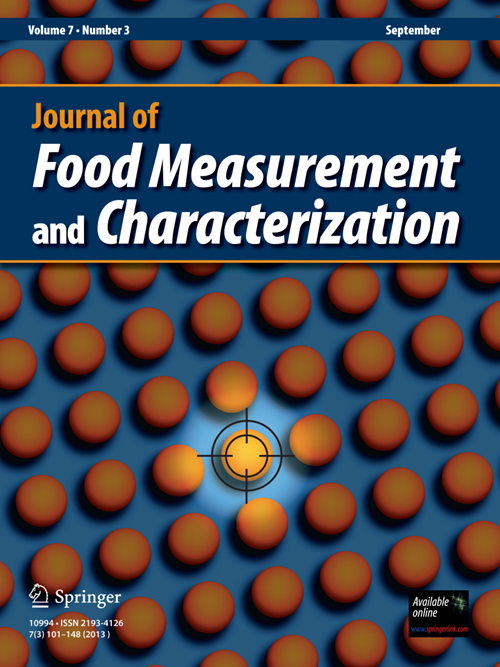比较提取方法和溶剂对紫色和蓝色色素花中植物化学物质生物活性的影响
IF 3.3
3区 农林科学
Q1 Engineering
Journal of Food Measurement and Characterization
Pub Date : 2023-09-25
DOI:10.1007/s11694-023-02158-2
引用次数: 1
摘要
摘要:许多植物的花具有强烈的颜色和丰富的生物活性化合物的特点。他们可以是他们的宝贵和好奇的来源,值得以尽可能高的效率提取。本研究比较了不同提取方法和超声处理对Malva sylvestris (MS)、Clitoria ternatea (CT)、Centaurea cyanus (CC)和Trifolium pratense (TP)干花瓣理化性质的影响。将花瓣磨碎,用三种方法提取:(1)H2O,(2) 70%甲醇,(3)70%甲醇+乙酸溶剂,加US。测量:CIEL*a*b*系统颜色参数;总抗氧化活性(TAA)指1,1-二苯基-2-吡啶肼(DPPH)和2,2 ' -氮基-双(3-乙基苯并噻唑-6-磺酸)(ABTS)自由基活性;用folin - ciocl - teu法测定总酚含量(TPC);pH差法测定总花青素含量(TAC)。没有发现颜色参数的具体差异。最高TAA(在DPPH还原性中%)- MS: 87.86;CT: 62.56;答:72.04;TP: 82.99), TPC(单位:没食子酸当量毫克/100克样品-质谱:1072.86;CT: 849.85;答:912.07;TP: 873.77)和TAC(单位:氰苷-3-葡萄糖苷毫克/100克样品-质谱:747.79;CT: 226.46;答:267.53;方法(3)达到TP: 234.77), US处理提高了效果。本文章由计算机程序翻译,如有差异,请以英文原文为准。
Comparison of the effects of extraction method and solvents on biological activities of phytochemicals from selected violet and blue pigmented flowers
Abstract The flowers of many plant species are characterized by intense color and richness of bioactive compounds. They can be their valuable and curious sources that are worth extracting with the highest possible efficiency. The study compares the effects of different extraction methods and ultrasound (US) treatment on the physicochemical properties of dried petals of Malva sylvestris (MS), Clitoria ternatea (CT), Centaurea cyanus (CC), and Trifolium pratense (TP). The petals were ground and then extracted by three methods: (1) with H2O, (2) with 70% methanol, (3) with 70% methanol + acetic acid solvents, additionally used US. Measured: color parameters in CIEL*a*b* system; total antioxidant activity (TAA) referred to the 1,1-diphenyl-2-picrylhydrazyl (DPPH) and 2,2’-azino-bis(3-ethylbenzothiazoline-6-sulfonic acid) (ABTS) radicals activity; total phenolic content (TPC) by the Folin-Ciocâlteu method; total anthocyanin content (TAC) by the pH differential method. No specific differences in color parameters founded. The highest TAA (in % of DPPH reductive- MS: 87.86; CT: 62.56; CC: 72.04; TP: 82.99), TPC (in mg gallic acid equivalent/100 g of sample- MS: 1072.86; CT: 849.85; CC: 912.07; TP: 873.77), and TAC (in mg of cyanidin-3-glucoside/100 g of sample- MS: 747.79; CT: 226.46; CC: 267.53; TP: 234.77) was reached by method (3). US treatment increased the effect.
求助全文
通过发布文献求助,成功后即可免费获取论文全文。
去求助
来源期刊

Journal of Food Measurement and Characterization
FOOD SCIENCE & TECHNOLOGY-
CiteScore
5.30
自引率
11.80%
发文量
0
期刊介绍:
This interdisciplinary journal publishes new measurement results, characteristic properties, differentiating patterns, measurement methods and procedures for such purposes as food process innovation, product development, quality control, and safety assurance.
The journal encompasses all topics related to food property measurement and characterization, including all types of measured properties of food and food materials, features and patterns, measurement principles and techniques, development and evaluation of technologies, novel uses and applications, and industrial implementation of systems and procedures.
 求助内容:
求助内容: 应助结果提醒方式:
应助结果提醒方式:


